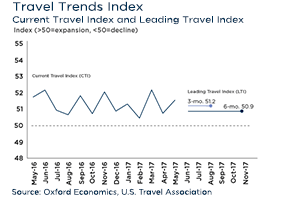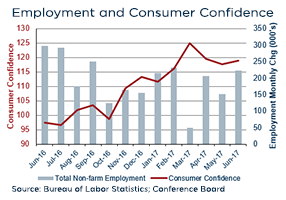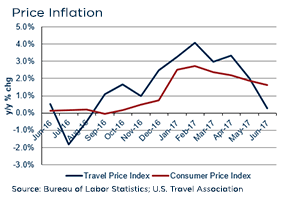U.S. Travel Outlook – July 2017
 What follows are some select excerpts from the latest U.S. Travel Association’s “U.S. Travel Outlook,” a compilation of current research and trends by David Huether. The industry insights we think may be of particular interest to Nevada Industry Partners include TRAVEL TRENDS INDEX, CONSUMER CONFIDENCE, and CONSUMER SPENDING. Read on!
What follows are some select excerpts from the latest U.S. Travel Association’s “U.S. Travel Outlook,” a compilation of current research and trends by David Huether. The industry insights we think may be of particular interest to Nevada Industry Partners include TRAVEL TRENDS INDEX, CONSUMER CONFIDENCE, and CONSUMER SPENDING. Read on!
TRAVEL TRENDS INDEX
 International travel continued to defy the expectations of many in May 2017, according to the U.S. Travel Association’s latest Travel Trends Index (TTI), posting its 13th straight month of year-over-year growth. International travel to the U.S. grew 5.2 percent in May versus the same month in 2016. In fact, the latest TTI even revised upward (to 6.6 percent) its positive international travel figure from April—the first month of datafully reflecting any effects of President Trump’s initial executive order on immigration issued January 27. Travel growth overall remained strong, buoyed by solid domestic travel demand—both business and leisure. Leisure travel continued to lead the domestic market, but business travel growth rallied after a lackluster performance in April that was largely attributable to the timing of holidays like Easter and Passover. Overall, travel will likely grow by about 1.8 percent through November 2017, and domestic travel growth will lead the U.S. travel market into the end of the year. However, while growth in forward-looking domestic bookings and searches remains positive, their pace of growth is markedly slower than this time last year.
International travel continued to defy the expectations of many in May 2017, according to the U.S. Travel Association’s latest Travel Trends Index (TTI), posting its 13th straight month of year-over-year growth. International travel to the U.S. grew 5.2 percent in May versus the same month in 2016. In fact, the latest TTI even revised upward (to 6.6 percent) its positive international travel figure from April—the first month of datafully reflecting any effects of President Trump’s initial executive order on immigration issued January 27. Travel growth overall remained strong, buoyed by solid domestic travel demand—both business and leisure. Leisure travel continued to lead the domestic market, but business travel growth rallied after a lackluster performance in April that was largely attributable to the timing of holidays like Easter and Passover. Overall, travel will likely grow by about 1.8 percent through November 2017, and domestic travel growth will lead the U.S. travel market into the end of the year. However, while growth in forward-looking domestic bookings and searches remains positive, their pace of growth is markedly slower than this time last year.
CONSUMER CONFIDENCE
 The Conference Board Consumer Confidence Index®, which had decreased in May, increased moderately in June. The Index now stands at 118.9, up from 117.6 in May. “Consumer confidence increased moderately in June following a small decline in May,” said Lynn Franco, director of economic indicators at The Conference Board. “Consumers’ assessment of current conditions improved to a nearly 16-year high. Expectations for the short-term have eased somewhat, but are still upbeat. Overall, consumers anticipate the economy will continue expanding in the months ahead, but they do not foresee the pace of growth accelerating.” Confidence in future economic prospects continued slipping into early July, the University of Michigan reported. U.S. consumer sentiment fell to 93.1 in the preliminary survey reading. Economists expected consumer sentiment to hit 95 in July, according to Thomson Reuters estimates. “Overall, the recent data follow the same pattern repeatedly recorded around past cyclical peaks: expectations start to post significant declines while assessments of current economic conditions continue to reach new peaks,” Richard Curtin, a chief economist for the University of Michigan’s Survey of Consumers, said in a statement. “To be sure, the data do not suggest an impending recession. … Much steeper declines in expectations typically precede recessions.” U.S. consumer sentiment last fell to 95.1 in June, sinking 2.1 percent from May. The declines being recorded by the group are “now consistent with just above 2 percent GDP growth in 2017,” Curtin said. “[T]he data indicate that hopes for a prolonged period of 3 percent GDP growth sparked by Trump’s victory have largely vanished…” Citigroup’s Economic Surprise Index, an indicator of how data are matching up to expectations, continues to plumb new depths. The performance of the U.S. economy has been disappointing this year to say the least, and in one respect it’s the biggest letdown since 2011. In fact, the index hasn’t been this low since late August 2011. “It’s a very, very cyclical indicator. The good news is that when it’s down this hard it usually starts to bounce back up,” said Ed Yardeni, head of Yardeni Research. Donald Trump’s November victory brought with it hopes that GDP growth would jump above 3 percent after an extended post-recession period milling around 2 percent. The Trump agenda of tax cuts, less regulation and infrastructure spending sparked a jump in multiple sentiment indicators and another leg up in the second-longest bull run in stock market history. However, the hard data have had a tough time keeping up with those high hopes, though expectations remain high—perhaps too high. Retail sales, job creation and productivity are just some of the economic reports that have fallen short of expectations recently. “The economy’s pretty much performing as it has since 2010,” Yardeni said. Americans’ confidence in the economy has somewhat stabilized, but remained at a 2017 low in June, with Gallup’s U.S. Economic Confidence Index averaging +3 for the second month in a row. Despite confidence lagging below January’s monthly record high of +11, June nonetheless marked the eighth consecutive month in which U.S. adults rated the economy positively. Only after Donald Trump’s election in 2016 did economic attitudes fundamentally change. Economic confidence peaked in January 2017, remaining high through March. U.S. stock markets soared during this time, and many analysts believed that some elements of Trump’s economic agenda—such as cutting taxes and increasing spending on infrastructure—would lead to an era of higher economic growth, although these projections have yet to materialize. Since March, confidence has softened somewhat, as democrats and independents have lost faith in the economy.
The Conference Board Consumer Confidence Index®, which had decreased in May, increased moderately in June. The Index now stands at 118.9, up from 117.6 in May. “Consumer confidence increased moderately in June following a small decline in May,” said Lynn Franco, director of economic indicators at The Conference Board. “Consumers’ assessment of current conditions improved to a nearly 16-year high. Expectations for the short-term have eased somewhat, but are still upbeat. Overall, consumers anticipate the economy will continue expanding in the months ahead, but they do not foresee the pace of growth accelerating.” Confidence in future economic prospects continued slipping into early July, the University of Michigan reported. U.S. consumer sentiment fell to 93.1 in the preliminary survey reading. Economists expected consumer sentiment to hit 95 in July, according to Thomson Reuters estimates. “Overall, the recent data follow the same pattern repeatedly recorded around past cyclical peaks: expectations start to post significant declines while assessments of current economic conditions continue to reach new peaks,” Richard Curtin, a chief economist for the University of Michigan’s Survey of Consumers, said in a statement. “To be sure, the data do not suggest an impending recession. … Much steeper declines in expectations typically precede recessions.” U.S. consumer sentiment last fell to 95.1 in June, sinking 2.1 percent from May. The declines being recorded by the group are “now consistent with just above 2 percent GDP growth in 2017,” Curtin said. “[T]he data indicate that hopes for a prolonged period of 3 percent GDP growth sparked by Trump’s victory have largely vanished…” Citigroup’s Economic Surprise Index, an indicator of how data are matching up to expectations, continues to plumb new depths. The performance of the U.S. economy has been disappointing this year to say the least, and in one respect it’s the biggest letdown since 2011. In fact, the index hasn’t been this low since late August 2011. “It’s a very, very cyclical indicator. The good news is that when it’s down this hard it usually starts to bounce back up,” said Ed Yardeni, head of Yardeni Research. Donald Trump’s November victory brought with it hopes that GDP growth would jump above 3 percent after an extended post-recession period milling around 2 percent. The Trump agenda of tax cuts, less regulation and infrastructure spending sparked a jump in multiple sentiment indicators and another leg up in the second-longest bull run in stock market history. However, the hard data have had a tough time keeping up with those high hopes, though expectations remain high—perhaps too high. Retail sales, job creation and productivity are just some of the economic reports that have fallen short of expectations recently. “The economy’s pretty much performing as it has since 2010,” Yardeni said. Americans’ confidence in the economy has somewhat stabilized, but remained at a 2017 low in June, with Gallup’s U.S. Economic Confidence Index averaging +3 for the second month in a row. Despite confidence lagging below January’s monthly record high of +11, June nonetheless marked the eighth consecutive month in which U.S. adults rated the economy positively. Only after Donald Trump’s election in 2016 did economic attitudes fundamentally change. Economic confidence peaked in January 2017, remaining high through March. U.S. stock markets soared during this time, and many analysts believed that some elements of Trump’s economic agenda—such as cutting taxes and increasing spending on infrastructure—would lead to an era of higher economic growth, although these projections have yet to materialize. Since March, confidence has softened somewhat, as democrats and independents have lost faith in the economy.
CONSUMER SPENDING
Consumer spending slowed down in May to a $7.3 billion monthly increase, a 0.1 percent seasonally-adjusted monthly growth rate, according to the Commerce Department. Personal incomes, on the other hand, increased 0.4 percent, boosting the personal savings rate to 5.3 percent, its highest level in eight months according to The Wall Street Journal. The May growth rate failed to maintain the momentum of two previous months of 0.4 percent seasonally-adjusted monthly growth of nominal consumer spending growth. “Americans are in good shape to increase consumption—the question is when?” Eugenio Alemán, senior economist at Wells Fargo, said in a note to clients. Estimates of consumer credit card spending noted that total consumer borrowing rose by 8.7 percent ($18.4 billion) in May, the strongest gain in credit card spending since a $25.1 billion increase in November. “It must come as a relief to the Fed given the softening in auto lending and credit card usage,” said Robert Frick, corporate economist at Navy Federal Credit Union, in a statement. According to Steve Goldstein at MarketWatch: “MarketWatch also reported that the growth in consumer credit was “faster than the… growth sell-side economists had forecast… The first quarter’s 4.8-percent growth in revolving credit outstanding was the slowest quarterly expansion in more than six years.” Prices may be drifting away from the Federal Reserve’s 2 percent target rate. The Fed’s preferred measure of inflation, the 12-month Personal Consumption Expenditure (PCE) Price Index, also softened in May to 1.4 percent year-on-year (y/y) from 1.7 percent y/y in April, according to the Commerce Department. “Although the real economy is doing well, Fed officials are concerned that isn’t translating into stronger inflationary pressures,” Paul Ashworth, chief U.S. economist at Capital Economics, said in a note to clients. The inflation slowdown came on the heels of a Federal Reserve’s recent June decision to announce two anti-inflationary measures: raising interest rates and drawing down the Federal Reserve’s $4.5 trillion portfolio in assets. Federal Reserve Chair Janet Yellen is less worried, stating in her semiannual Congressional testimony that the inflation slowdown reflected largely temporary factors: “It’s premature to reach the judgment that we’re not on the path to 2-percent inflation over the next couple of years. As we indicate in our statement, it’s something we’re watching very closely, considering risks around the inflation outlook.”  The Labor Department released a similarly underwhelming Consumer Price Index (CPI-U) for June, with month-on-month (m/m) inflation unchanged from the previous month. The 12-month indicator for CPI-U inflation also disappointed in June, registering at 1.6 percent, the smallest advance since October 2016. Nevertheless, core inflation (CPI-U excluding food and energy) accelerated 0.1 percent m/m, up 1.7 percent from 12 months ago, lower than expectations from economists surveyed by Bloomberg. Economists remain relatively pessimistic about the release, including Paul Ashworth, chief U.S. economist at Capital Economics: “On the basis of June’s data, it is getting harder for the Fed to continue claiming that this is a temporary drop-off.” Notably, air fares declined 2.7 percent y/y in June, a reading that certainly affected U.S. Travel’s June 2017 Travel Price Index (TPI). TPI for June decreased 1.3 percent on a m/m, seasonally adjusted basis. In addition to air fares, Other lodging decreased by 2.3 percent while prices for motor fuel decreased by 2.8 percent. The 12-month TPI increased by 0.3 percent in June, much slower than the 1.6 percent registered for CPI-U. June U.S. consumer spending neared a nine-year high at $103 per day, according to Gallup. The $103 per day average was the highest monthly average since consumers reported spending $104 per day in June 2008. While the average daily spend actually decreased from $104 per day in May, but has remained stable for most of the year. Gallup reports that “[though] Americans’ confidence in the U.S. economy has edged down from the high points recorded after last fall’s presidential election, their spending hasn’t slowed. If July spending follows the typical pattern of being similar to June, spending will have averaged a three-digit figure for the sixth month in a row.”
The Labor Department released a similarly underwhelming Consumer Price Index (CPI-U) for June, with month-on-month (m/m) inflation unchanged from the previous month. The 12-month indicator for CPI-U inflation also disappointed in June, registering at 1.6 percent, the smallest advance since October 2016. Nevertheless, core inflation (CPI-U excluding food and energy) accelerated 0.1 percent m/m, up 1.7 percent from 12 months ago, lower than expectations from economists surveyed by Bloomberg. Economists remain relatively pessimistic about the release, including Paul Ashworth, chief U.S. economist at Capital Economics: “On the basis of June’s data, it is getting harder for the Fed to continue claiming that this is a temporary drop-off.” Notably, air fares declined 2.7 percent y/y in June, a reading that certainly affected U.S. Travel’s June 2017 Travel Price Index (TPI). TPI for June decreased 1.3 percent on a m/m, seasonally adjusted basis. In addition to air fares, Other lodging decreased by 2.3 percent while prices for motor fuel decreased by 2.8 percent. The 12-month TPI increased by 0.3 percent in June, much slower than the 1.6 percent registered for CPI-U. June U.S. consumer spending neared a nine-year high at $103 per day, according to Gallup. The $103 per day average was the highest monthly average since consumers reported spending $104 per day in June 2008. While the average daily spend actually decreased from $104 per day in May, but has remained stable for most of the year. Gallup reports that “[though] Americans’ confidence in the U.S. economy has edged down from the high points recorded after last fall’s presidential election, their spending hasn’t slowed. If July spending follows the typical pattern of being similar to June, spending will have averaged a three-digit figure for the sixth month in a row.”